There are many different types of bake-ware available for baking a variety of baked goods. Some types are essential in producing the desired end product and some bake-ware can be used for several purposes. Bake-ware can be found made of many types of material, such as tinned steel, stainless steel, glass, silicone and stone. The type of material the pan is made from can have an effect on the cooking times or temperatures, requiring that they be adjusted.
 Below is a list of different types of baking pans available. It is not an exhaustive list, so if I have left out anything, please let me know.
Below is a list of different types of baking pans available. It is not an exhaustive list, so if I have left out anything, please let me know.
======================================================================
Sources - Wiki, recipetips, johnlewis, cooking, shopcookware, saltandpepper, kitchencontraptions, jbprince, wassertrom, oneida

Baking Dish 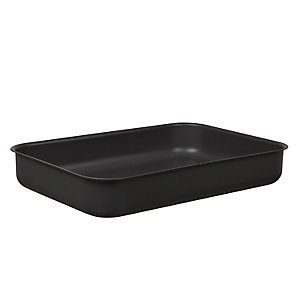 | A pan with straight sides that are 3/4 inch or taller, which is used for baking food in the oven. There are many sizes and depths available, but the most common sizes is 9 x 13 inches Typical dishes that are prepared in such baking pans include: cakes, brownies, bars, breads, dinner rolls, cookies, lasagna, egg dishes, potato and other vegetable dishes. | ||
Baking Sheet  | A flat pan or sheet of metal that is used to bake products that are thick or stiff enough to stand on their own, such as cookies, freestanding breads, biscuits, pastries, and meringues. Baking sheets are also referred to as cookie sheets. It you have a baking dish, there’s no need to get a baking sheet too. | ||
Cake Pan
 | A baking pan commonly found in every kitchen. Cake pans can be round, square or rectangular and are available in several sizes and shapes. Standard square cake pans are 8 or 9 inches wide and 1 ½ inches in depth. Round cake pans are used to make layer cakes and are generally found in 8 or 9-inch diameters and are 1 ½ inches in depth.  | ||
Bundt Pan 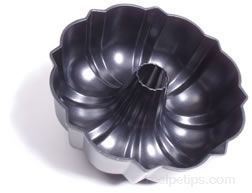 | A heavy-walled baking pan formed with a decorative indented curvature and a hollow tube in the center. The heavier walled construction and hollow center tube allows cake batters to rise and bake more uniformly, creating a golden crust on the outside of the cake. This pan is generally used for baking coffee cakes and sweet cakes, referred to as bundt cakes. | ||
Doughnut Pan  | A pan that is constructed similar to a muffin tin except that the cups have a rounded bottom and a stem that comes up in the center of each cup to create the hole in the doughnut. The pan helps produce a lower calorie doughnut because they are baked rather than fried in oil. Also known as Donut pan | ||
Tube Pan  Detachable bottom Detachable bottom | A deep baking pan that has a hollow tube in the center, which allows for more uniform baking. A tube pan is used for baking cakes such as angel food and sponge cake. Tube pans can be made as a single piece of metal or as two pieces of metal consisting of a side and a flat round bottom that is removable. They are also referred to as an angel food cake pan 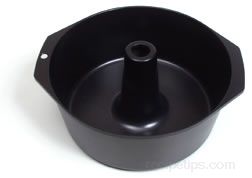 single piece single piece | ||
Muffin Tin | A type of pan used for baking muffins. The pan typically will have 6 or 12 individual round pockets or holders connected to the tin and formed in the shape of a muffin. The muffin batter is poured into the individual pockets and as the muffin bakes, a top forms over the pocket while the base of the muffin is baked in the shape of the cup They are also used to bake cupcakes. | ||
Silicone Muffin Cups | Individual muffin cups made from silicone are also available for baking individual cupcakes and muffins. Muffin tins may also be referred to as muffin pans or cupcake pans. | ||
Bread Pan (Loaf Tin)  | A baking pan, rectangular in shape and deep walled, that is used to bake a single loaf of bread. Bread pans are typically made from aluminum, steel, glass. They are produced to make a semi-crisp crust with an evenly textured crumb  | ||
Brioche Pan 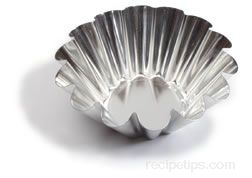 | A type of pan or mold with fluted sides that is used to form the base of the traditional French bread known as Brioche. Tinned steel molds will last a very long time, with just a little care. Wash them by hand, and dry thoroughly before storing. For long term storage, lightly grease the entire surface of the mold and put the mold in wax paper or plastic bags | ||
French Bread Pan  | A type of metal or aluminum pan that is 16 to 20 inches in length and formed with a curved base so that long lengths of dough can be laid horizontally in them to be baked into baguettes The pan is available constructed with non-sticking metal surfaces as well as porus clay stoneware. | ||
Pie Plate  | A round baking dish with shallow slanted sides that are 1 to 1 1/2 inches deep. The pie plate is available in several sizes. The most common sizes being 8, 9 and 10 inch diameters. Pie plates are used to bake single crust and double crust pies. They are also available in a deep dish variety that has slanted sides. The deep dish pie plate is most often used to bake a savory dish. A pie plate is also referred to as a pie tin. | ||
Tart Pan 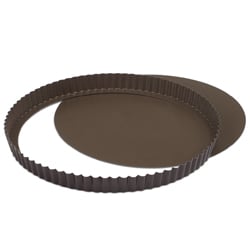 | A round or oblong shallow pan with smooth or fluted sides and a removable bottom. The pan is constructed with a removable bottom so the baked tart can be pushed up out of the pan, allowing the contents to be removed easily and cleanly, while retaining the shape created by the fluted sides. The small pans for individual round servings range in size from 3 to 5 inches in diameter while the larger pans for pie-shape servings commonly range in size from 9 and 11 inches in diameter | ||
Springform Pan 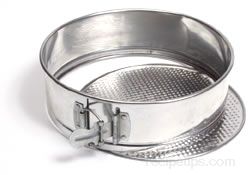 | A springform pan is a type of bakeware that features sides that can be removed from the base. It's hard to get a cake out of a regular pan, but with a springform, you just pop it open and the sides come off. Then you can serve the cake directly on the pan base. The less you transfer and shift a cake around, the less chance you have of breaking or messing it up. Best suited for cheesecake, mousse etc. | ||
Ramekins 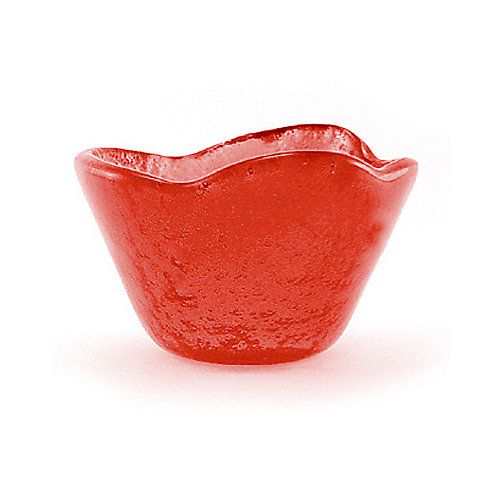 | A ramekin or ramequin, also known as a bouillon bowl, is a small glazed ceramic or glass serving bowl used for the preparation and serving of dishes such as crème brûlée, French onion soup, Molten chocolate cake, moimoi, cheese or egg dishes, poi, potted shrimps, ice cream, soufflé, baked "cocottes", crumbles etc. Ramekins are often built to withstand high temperatures, as they are frequently used in ovens, or in the case of crème brûlée, exposed to the flare of a cooking torch |
Sources - Wiki, recipetips, johnlewis, cooking, shopcookware, saltandpepper, kitchencontraptions, jbprince, wassertrom, oneida

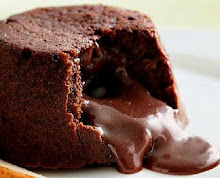





















Useful Post Kavi........
ReplyDeleteVery nice post on baking pans. Regarding the best material for baking pans , most bakers like Rose Levy Berenbaum or Flo Braker recommend dull heavy gauge aluminum pans with straight rather than flared sides. For glass or dark pans it is recommended to lower the temperature by 25 degrees.
ReplyDeleteNice information !!
ReplyDeleteOngoing event
CC:Mom's Recipe
Very informative
ReplyDeleteGood one.Love this !
http://followfoodie.blogspot.com
u did your research well, I am way impressed:-)
ReplyDeletewhoa! excellent research and explanations, Kavi.
ReplyDeletei think you've covered almost everything possible!
if i may add, there's a mini muffin pan too.
and i think the flatter wide small bowl/plate hidden in the pic beside ramekins is used for quiches/tart, etc too.
How are exams going on?
I love this post! So interesting and informative, and you really did some good research. I use mainly silicone for cakes and nut roasts now, though I love my springform pans. I used to have some ceramic flan dishes from France which were brilliant- pastry crust always seemed to come out so crisp! Good luck with your exams :)
ReplyDeleteBaking Pans are available on e-bay now...
ReplyDeletehttp://myworld.ebay.in/bakersstuff
Even if your desired item is not available you can check with seller he might be able to arrange it.
thanks,
Manu